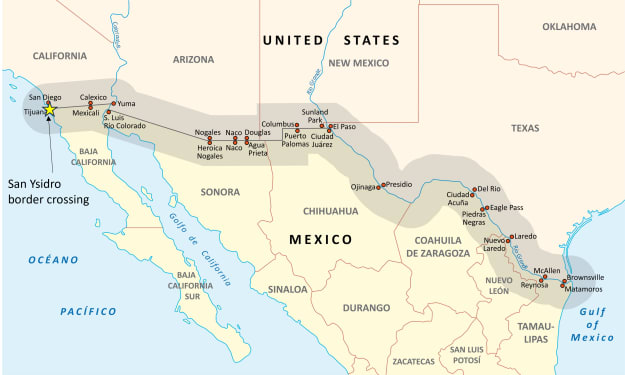A Journey Through the World of Languages: Types, Origins, and Regions
Exploring the Diversity and Beauty of Linguistic Expression

Languages are an essential aspect of human communication, with over 7,000 spoken languages across the world. These languages can be classified in various ways, such as by region, writing system, and other factors. In this article, we will explore the types of languages spoken, including those that have and don't have a written format, and their origins.
Oral Languages
Oral languages, also known as unwritten languages, are spoken languages that do not have a written form. These languages are passed down from generation to generation through speech, songs, and other forms of verbal communication. Many indigenous communities around the world speak unwritten languages, such as some of the languages spoken in Africa and South America.
Here are some examples of such languages and their respective regions:
- Yoruba - West Africa: Yoruba is a tonal language spoken in Nigeria, Benin and Togo. It is one of the four largest languages spoken in Nigeria and has over 20 million speakers.
- Quechua - South America: Quechua is an indigenous language spoken in the Andean region of South America. It is the second most spoken language in Peru and has around 8-10 million speakers worldwide.
- Nahuatl - Mexico and Central America: Nahuatl is a family of indigenous languages spoken in Mexico and Central America. It was the language of the Aztecs and is still spoken by around 1.5 million people.
- Toda - India: Toda is a Dravidian language spoken in the Nilgiri hills of Southern India. It has around 1,800 speakers and is considered a vulnerable language.
- Ainu - Japan: Ainu is an indigenous language spoken in Japan, particularly in the Hokkaido region. It has around 15 speakers and is classified as an endangered language.
- Hmong - Southeast Asia: Hmong is a language spoken by the Hmong people in Southeast Asia. It is a tonal language with no official writing system and has over 4 million speakers worldwide.
- Basque - Spain and France: Basque is a language spoken in the Basque Country of Spain and France. It is an isolated language with no known relatives and has around 700,000 speakers.
- Khoisan - Southern Africa: Khoisan is a group of languages spoken in Southern Africa, particularly in Namibia and Botswana. They are known for their use of click consonants and are considered endangered languages.
- Pirahã - Brazil: Pirahã is a language spoken by the Pirahã people in the Amazon region of Brazil. It is a tonal language with no concept of numbers or colours and has around 800 speakers.
- Tuyuca - Brazil: Tuyuca is an indigenous language spoken in the Amazon region of Brazil. It is known for its complex grammar, including over 50 noun classes and evidentiality, and has around 1,000 speakers.
Signed Languages
Signed languages, also known as sign languages, are languages that use hand gestures and body language to convey meaning. These languages are used primarily by deaf or hard-of-hearing individuals, and they have their grammar and syntax, just like spoken languages. American Sign Language (ASL) and British Sign Language (BSL) are two examples of signed languages. Some list of Languages with country names
- American Sign Language (ASL) - North America
- British Sign Language (BSL) - United Kingdom
- Australian Sign Language (Auslan) - Australia
- New Zealand Sign Language (NZSL) - New Zealand
- French Sign Language (LSF) - France
- German Sign Language (DGS) - Germany
- Japanese Sign Language (JSL) - Japan
- Chinese Sign Language (CSL) - China
- Russian Sign Language (RSL) - Russia
- Israeli Sign Language (ISL) - Israel
- Swedish Sign Language (SSL) - Sweden
- Norwegian Sign Language (NSL) - Norway
- Danish Sign Language (DTS) - Denmark
- Finnish Sign Language (FSL) - Finland
- Spanish Sign Language (LSE) - Spain
- Italian Sign Language (LIS) - Italy
- Brazilian Sign Language (LIBRAS) - Brazil
- Mexican Sign Language (LSM) - Mexico
- South African Sign Language (SASL) - South Africa
- Indian Sign Language (ISL) - India
Each of these signed languages has its #own #unique #grammar, #syntax, and #vocabulary. They are used by #deaf and #hard-of-hearing people to communicate with each other and with hearing people who know the language. #Sign #languages are often recognized as #official languages in their respective countries and are an important part of #deaf culture.
Written Languages
Written languages are languages that have a written form that is used for communication. These languages can be categorized by their writing systems, such as alphabets, syllabaries, or logographic systems. Some of the most widely spoken languages in the world, such as Tamil, English, Spanish, and Mandarin, have a written form.
Here are some examples of written languages and their regions:
- English - spoken and written in various countries including the United Kingdom, the United States, Canada, Australia, and New Zealand.
- Tamil - primarily spoken and written in the Indian state of Tamil Nadu and in the northeastern region of Sri Lanka, and spoken by significant populations in other countries including the Singapore, Malaysia, Mauritius, Canada, USA, UK, Australia, France, Germany, United Arab Emirates.
- Mandarin Chinese - primarily spoken and written in China, but also in Taiwan, Singapore, and Malaysia.
- Arabic - spoken and written in many Middle Eastern countries including Egypt, Saudi Arabia, Iraq, and Lebanon.
- Spanish - spoken and written in many countries in Latin America, as well as Spain.
- Hindi - spoken and written in India, as well as in Nepal and Mauritius.
- Russian - primarily spoken and written in Russia, but also in countries that were part of the former Soviet Union such as Kazakhstan, Belarus, and Ukraine.
- French - spoken and written in many countries including France, Canada, Switzerland, and many African countries.
- German - primarily spoken and written in Germany, but also in Austria, Switzerland, and Luxembourg.
- Japanese - spoken and written in Japan.
- Korean - primarily spoken and written in South Korea, but also in North Korea.
It's worth noting that some languages may have variations in their written forms depending on the country or region where they are used. For example, British English and American English may have slight differences in spelling and word usage, while Chinese characters may be simplified or traditional depending on the region.
Mixed Languages
Mixed languages are languages that combine elements from two or more different languages. These languages can be formed through contact between different language communities or through the development of pidgin languages, which are simplified languages used for communication between people who do not share a common language. Some examples of mixed languages include Haitian Creole, which is a blend of French and various West African languages, and Michif, which is spoken in Canada and combines elements of French and Cree.
Here are some examples of mixed languages and the regions where they are spoken:
- Haitian Creole - spoken in Haiti and by the Haitian diaspora.
- Tok Pisin - spoken in Papua New Guinea and the Torres Strait Islands.
- Michif - spoken in Canada, particularly in the provinces of Manitoba and Saskatchewan.
- Bislama - spoken in Vanuatu.
- Papiamento - spoken in Aruba, Bonaire, and Curacao.
- Chavacano - spoken in the Philippines, particularly in the Zamboanga Peninsula.
- Kriol - spoken in Belize and parts of Guatemala and Mexico.
- Sango - spoken in the Central African Republic.
- Gurindji Kriol - spoken in the Victoria River District of the Northern Territory, Australia.
- Media Lengua - spoken in Ecuador.
These languages vary in their linguistic structure and the languages that they have developed from. Some have a heavier influence from one language over another, while others have developed into fully fledged languages in their own right. Regardless of their origins, mixed languages continue to be important for the communities that use them, often as a means of communication across linguistic and cultural boundaries.
Constructed Languages
Constructed languages, also known as artificial languages, are languages that are created for specific purposes, such as for use in literature or film. These languages can be created from scratch, or they can be based on existing languages. One of the most well-known constructed languages is Klingon, which was created for the Star Trek franchise.
Here are some examples of constructed languages and their regions of origin:
- Esperanto - created in 1887 by L.L. Zamenhof, a Polish ophthalmologist, and intended as a universal language for international communication. Origin: Europe.
- Klingon - created for the Star Trek franchise as the language of the Klingon species. Origin: North America.
- Elvish - created by J.R.R. Tolkien for his fictional world of Middle-earth, used by Elves and other creatures. Origin: Europe.
- Dothraki - created for the Game of Thrones television series as the language of the Dothraki people. Origin: North America.
- Na'vi - created for the Avatar movie as the language of the Na'vi people. Origin: North America.
- Toki Pona - a minimalist language created by Canadian linguist Sonja Elen Kisa. Origin: North America.
- Ithkuil - a philosophical language created by American John Quijada, designed to express complex thoughts with precision. Origin: North America.
- Volapük - created in the late 19th century as a universal language for international communication. Origin: Europe.
- Loglan - created by James Cooke Brown in the 1950s for linguistic experimentation and as a potential international language. Origin: North America.
- Blissymbols - created by Charles Bliss in the 1940s as a universal writing system for communication. Origin: Europe.
#தமிழ் #tamillanguage #learnTamil #english #englishlanguage #learnenglish #español #aprendeEspañol #spanishlanguage #français #apprendrefrançais #frenchlanguage #deutsch #deutschlernen #中文 #学中文 #chineselanguage #عربي #تعلم_العربية #arabiclanguage #português #aprenderportuguês #portugueselanguage #日本語 #日本語勉強 #japaneselanguage #русский #учитьрусский #russianlanguage #한국어 #한국어배우기 #koreanlanguage
About the Creator
kulandaivel
"Creative writer sharing passions for travel, music, and nature through relatable and inspiring stories. Aiming to engage audience and bring positivity to the world. Excited to be a part of the Vocal community."






Comments
There are no comments for this story
Be the first to respond and start the conversation.